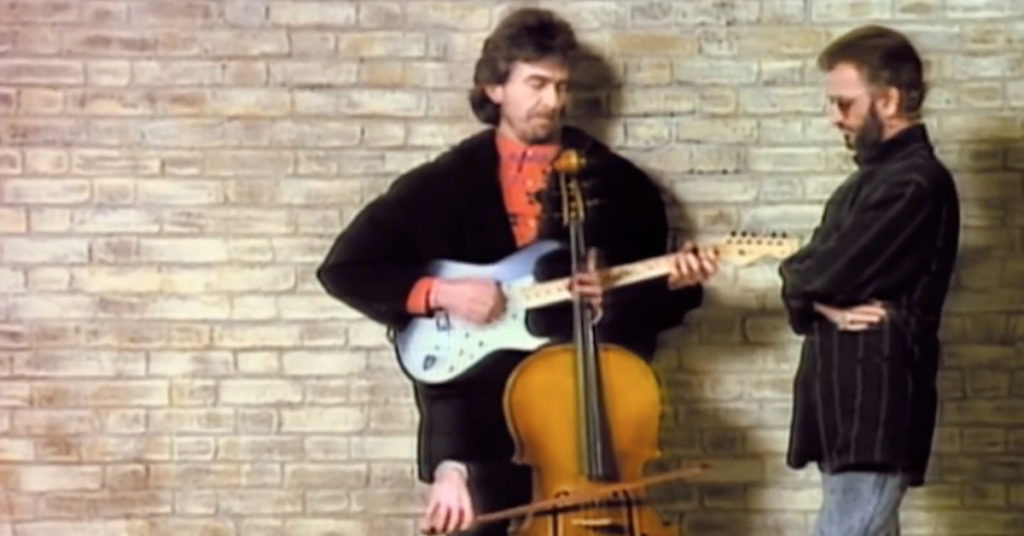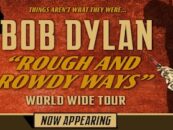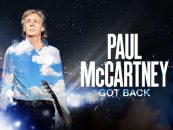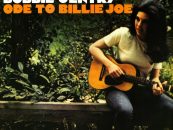 In 1961, the 18-year-old George Harrison purchased his first American-made guitar, a 1957 Gretsch Duo Jet, from a former merchant seaman named Ivan Heyward, for 75 pounds sterling, after he saw an advertisement in the Liverpool Echo. After giving it good use on “Please Please Me” and “I Saw Her Standing There,” he eventually passed it to his old friend from the Beatles’ days in Hamburg, Germany, the artist/musician Klaus Voormann. When Harrison was ready to shoot the cover for his new album Cloud Nine in 1987, he retrieved his “old black Gretsch” from storage in Los Angeles, had it refurbished, and posed with it, smiling widely in front of a stratospheric backdrop. You couldn’t see his eyes because of the light flare in his sunglasses, but it’s pretty clear from the content of the album they were twinkling with mischief.
In 1961, the 18-year-old George Harrison purchased his first American-made guitar, a 1957 Gretsch Duo Jet, from a former merchant seaman named Ivan Heyward, for 75 pounds sterling, after he saw an advertisement in the Liverpool Echo. After giving it good use on “Please Please Me” and “I Saw Her Standing There,” he eventually passed it to his old friend from the Beatles’ days in Hamburg, Germany, the artist/musician Klaus Voormann. When Harrison was ready to shoot the cover for his new album Cloud Nine in 1987, he retrieved his “old black Gretsch” from storage in Los Angeles, had it refurbished, and posed with it, smiling widely in front of a stratospheric backdrop. You couldn’t see his eyes because of the light flare in his sunglasses, but it’s pretty clear from the content of the album they were twinkling with mischief.
Frustrated by the business side of making music, Harrison had been in semi-retirement for nearly a decade, getting involved in race car driving, gardening and movies through his company Handmade Films. In 1979 he told Rolling Stone’s Mick Brown, “I stay home and dig, not so much with a spade, but I dig the garden, putting trees in. I like gardens; I like the pleasure they give you. It’s like a meditation in a way—you can get everything out of your mind groveling in the soil! I spend a lot of time with the wife and the baby.”
Still, he had a full recording studio at Friar Park, his Victorian mansion in Oxfordshire, England, and had put out a few albums on his own label Dark Horse, now distributed by Warner Bros. Records. Only one of them, 1981’s Somewhere In England, had yielded a bona-fide pop hit, his heartfelt tribute to the recently murdered John Lennon, “All Those Years Ago.”
He told Brown, “I still enjoy writing a tune and enjoy in a way making a record. But I hate that whole thing of when you put it out, you become a part of the overall framework of the business. And I was a bit bored with that. If I write a tune and people think it’s nice then that’s fine by me; but I hate having to compete and promote the thing. I really don’t like promotion. In the ’60s we overdosed on that.”
Recorded between January and August 1987, Cloud Nine represented a major comeback for Harrison, who got his first American #1 hit in 16 years with “Got My Mind Set on You,” his version of an obscure 1962 James Ray single on the Dynamic Sound label. Shortly after its early November 1987 release, the Cloud Nine album made it into the top 10 of Billboard’s album chart even without a tour to support sales; the success energized Harrison enough to launch into another project with his Cloud Nine co-producer Jeff (ELO) Lynne, which eventually resulted in an even bigger hit with the Traveling Wilburys, a supergroup quintet featuring Bob Dylan, Roy Orbison and Tom Petty.
Related: Our Album Rewind of the Traveling Wilburys’ debut
The numerically retitled opening track “Cloud 9” leads off, with Eric Clapton on guitar, Elton John on electric piano, Jim Keltner drumming, Lynne on bass and Jim Horn’s punchy saxophones. Harrison’s vocal is intimate and sensual, placed in the mix perfectly by engineer Richard Dodd and the Lynne-Harrison co-production team. Harrison’s playing the slide guitar in the left channel while Clapton emotes in the right, and Lynne’s also got some guitar lines in there. It’s downright funky as Harrison sings “Have my love/It fits you like a glove/Join my dream, tell me yes/Bail out should there be a mess/The pieces you don’t need are mine/Take my time/I’ll show you cloud nine/Take my smile and my heart/They were yours from the start/The pieces to omit are mine.”
Lynne’s Oberheim synthesizer leads off the mid-tempo “That’s What It Takes,” which he co-wrote with Harrison and his old friend Gary Wright. Harrison’s slide work is captured in an airy arrangement that includes luscious harmonies from Lynne-Harrison that (no surprise) recall the Electric Light Orchestra. The last minute is turned over to Clapton, who turns in a relatively restrained, but quite lovely, solo. As Harrison once said about the sonic palette of Cloud Nine, “All the little twiddly parts that just crop up, like autoharps, is just me and Jeff, and we also do all the backing voices.”
“Fish on the Sand” is a rocker that wears its drive lightly. There’s a chiming 12-string guitar part, celestial backing vocals, and a confident Harrison lead voice, with more than a hint of Orbison. Keltner is solid as always as the track looks forward to the Wilburys sound to come.
Harrison told Creem magazine he wrote the ballad “Just for Today” “from an Alcoholics Anonymous brochure. You know that little leaflet they give out to drunkards, to say to try to live through this day, for today only?” Wright is playing acoustic piano, and the lead vocal is measured and tender: “If just for one night/I could feel not sad and lonely/Not be my own life’s problem/Just for one night.” The melody is one of Harrison’s best, and the multiple guitar parts are sublime; Lynne perhaps over-eggs the “heavenly” backing vocals.
“This Is Love” is a Harrison-Lynne co-write, and sounds more like an ELO reject than it should when the backing vocals soar and the do-nothing chorus of “This is la la la love” kicks in. The synth lines are just place holders, but the guitars are reliable.
Luckily, the first side of the original LP ends with the winning “When We Was Fab,” which was released as the second single from Cloud Nine and got considerable airplay. Harrison told writer J. Kordosh, “Before I wrote the song, or when I sat down to write it, I thought, ‘This one’s gonna start with Ringo going one, two, DUHtabumb, DUHtabump.’ That was the intro in my head; that was the tempo it was always going to be.” Indeed, it launches with a miniature Beatles pastiche, Bobby Kok on cello recalling “I Am the Walrus,” percussionist Ray Cooper walloping timpani, and Wright channeling “Lady Madonna.” Ever since his early days with the Idle Race and ELO, Lynne studied every nuance of Beatles records, and the chance to co-design this homage must have thrilled him.
The track is full of delights, from Ringo’s Abbey Road-ish drumming to the swooping backing vocals swiped from “I Am the Walrus” and Harrison’s coda on sitar. The nostalgia is leavened with wit: “Back then long time ago when grass was green/Woke up in a daze/Arrived like strangers in the night/Long time ago when we was fab/Back when income tax was all we had.” Before calling the album Cloud Nine, Harrison says “I wracked my brains for a title, trying to think of something that didn’t have one of the song titles in it. It was called ‘Fab’ for about half an hour.”
“Devil’s Radio” leads off side two, with Elton John and Clapton on board once again. In Creem, Harrison explained, “I have to go past this little church to take my boy to school and they have a little billboard—just a little board outside the church—saying, ‘Gossip: The Devil’s Radio…Don’t Be A Broadcaster.’ That’s all. So I thought, that’s good, that’s a song.” It’s a convincing rocker, with Clapton finding plenty of room for interjections, and the added guitars of Lynne and Harrison adding some Dave Edmunds-like heft. The lyrics are fun: “He’s in the clubs and bars/And never turns it down/Talking about what he don’t know/On the devil’s radio/He’s in your TV set/Won’t give it a rest/That soul betraying so and so/The devil’s radio/Gossip, gossip.”
The album stumbles with “Someplace Else.” It has some characteristic Harrison chord changes that recall “If Not for You,” and some deft slide guitar, but sounds under-developed nonetheless, sounding like a sketch rushed into existence. (A previous version had already been used for a Handmade-produced film starring Sean Penn and Madonna, the critical and commercial bomb Shanghai Surprise.)
The following “Wreck of the Hesperus” has an echo of “Glass Onion” in Horn’s one-man sax section, but has a chaotic, kitchen-sink feel: the songwriting doesn’t have a strong center and Clapton fails to fit in.
“Break Away From Heaven” is an ambitious blend of Eastern sounds (China, Japan and India in a mix), with Cooper’s percussion, Harrison’s autoharp and other elements in a slow-churning atmosphere. In several ways it’s an impressive change of pace, with a fine Harrison vocal, but being another refugee from Shanghai Surprise, it perhaps should have been reconsidered as part of Cloud Nine. (A track called “Zig Zag” was used as the B-side to the “When We Was Fab” single, and another titled “Shanghai Surprise” was appended to a 2004 CD reissue.)
Saving the best for last, “Got My Mind Set on You” is a blast. Written by Rudy Clark, the co-composer of rock and soul classics including “Good Lovin’,” “It’s In His Kiss” and “If You Gotta Make a Fool of Somebody,” the song is approached from a different angle than the James Ray original. Mostly ditching the prominent horn section until a judicious return in the second half, Lynne and Harrison focus on keyboards and guitars, and Keltner’s slamming 2/4 time. There’s an Elvis swagger in Harrison’s vocal, especially when “this time I know it’s for real/the feelings that I feel” comes around, and one can’t help but detect a nod to Lennon’s lead vocal on the Beatles “Money” any time he sings that word. The infectious choruses, which simply repeat the title, have a grooving reggae beat. Jim Horn unleashes his inner King Curtis during the last minute. The performance is pure joy, a true dancefloor-filler beamed in from another era.
In 1991, after the Traveling Wilburys’ inspired hilarity, Harrison joined Clapton for a tour of Japan; it was to be his last full trek. He played at a tribute to Bob Dylan at Madison Square Garden in October 1992, and continued to be involved in various Beatles archive projects. He was treated for throat cancer in 1997: he’d been a heavy smoker for some time. On Dec. 30, 1999, he and his wife Olivia were attacked at home by a deranged intruder, and Harrison suffered a punctured lung and other injuries. His health deteriorated, with brain and lung cancer requiring surgery. When it came to evaluating his contribution to music history, Harrison was fond of quoting Gandhi, who, speaking in a non-judgmental way, said, “Create and preserve the image of your choice.”
Listen to “Zig Zag” and “Shanghai Surprise,” the tracks that were later added to CD versions of the album
At the age of 58, George Harrison died in Beverly Hills, Calif., on Nov. 29, 2001, while staying at a property owned by Paul McCartney. His ashes were scattered on the Ganges and Yamuna rivers in his beloved India. His posthumous contribution to “the last Beatles song,” “Now and Then,” came out on Nov. 2, 2023.
Harrison’s solo catalog, including November 2024’s expanded edition of 1973’s Living in the Material World, is available in the U.S. here and in the U.K. here.







2 Comments so far
Jump into a conversationThis was fun. I have to revisit this LP. I could always use some sort of Cloud Nine!
I worked for a radio station in Tampa at that time. The morning show was a format popular at the time, The Q “Morning Zoo”. They tweaked the vocal a bit so you heard the lyric as ‘Got my mind set on ZOO’. It ran once a shift for several weeks, no doubt aiding the song’s run to #1.